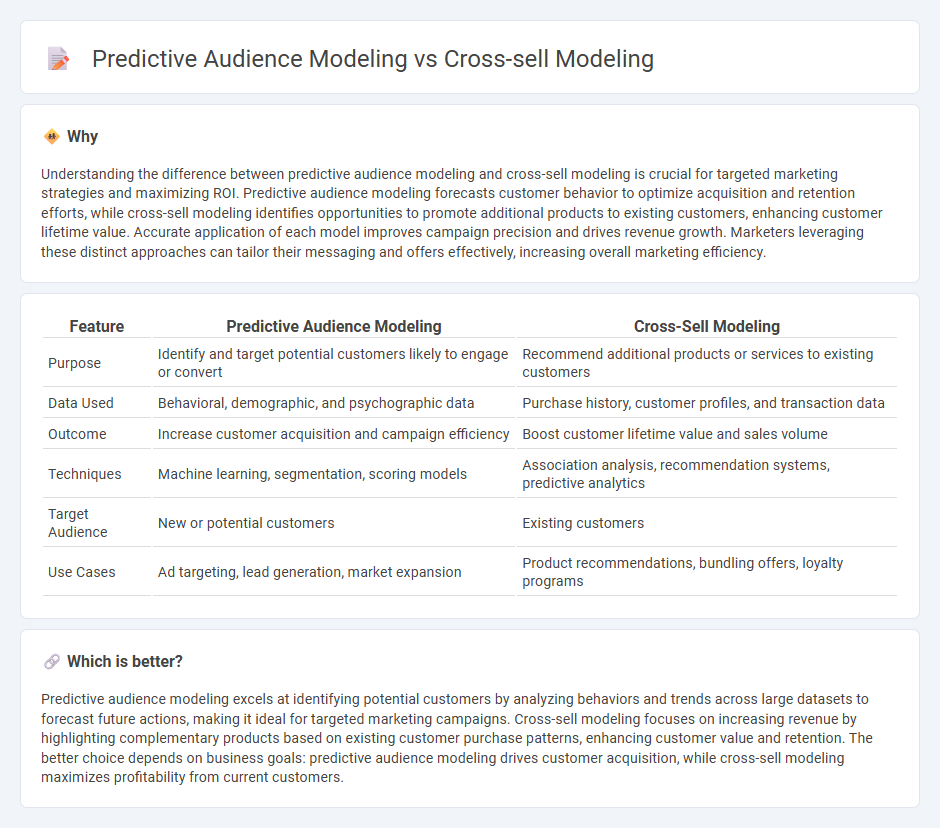
Predictive audience modeling leverages data analytics and machine learning to identify potential customers most likely to engage with marketing campaigns, enhancing targeting precision and campaign effectiveness. Cross-sell modeling focuses on analyzing existing customer behavior and preferences to recommend complementary products, increasing customer lifetime value and boosting sales revenue. Explore these advanced strategies to maximize marketing ROI and foster deeper customer relationships.
Why it is important
Understanding the difference between predictive audience modeling and cross-sell modeling is crucial for targeted marketing strategies and maximizing ROI. Predictive audience modeling forecasts customer behavior to optimize acquisition and retention efforts, while cross-sell modeling identifies opportunities to promote additional products to existing customers, enhancing customer lifetime value. Accurate application of each model improves campaign precision and drives revenue growth. Marketers leveraging these distinct approaches can tailor their messaging and offers effectively, increasing overall marketing efficiency.
Comparison Table
| Feature | Predictive Audience Modeling | Cross-Sell Modeling |
|---|---|---|
| Purpose | Identify and target potential customers likely to engage or convert | Recommend additional products or services to existing customers |
| Data Used | Behavioral, demographic, and psychographic data | Purchase history, customer profiles, and transaction data |
| Outcome | Increase customer acquisition and campaign efficiency | Boost customer lifetime value and sales volume |
| Techniques | Machine learning, segmentation, scoring models | Association analysis, recommendation systems, predictive analytics |
| Target Audience | New or potential customers | Existing customers |
| Use Cases | Ad targeting, lead generation, market expansion | Product recommendations, bundling offers, loyalty programs |
Which is better?
Predictive audience modeling excels at identifying potential customers by analyzing behaviors and trends across large datasets to forecast future actions, making it ideal for targeted marketing campaigns. Cross-sell modeling focuses on increasing revenue by highlighting complementary products based on existing customer purchase patterns, enhancing customer value and retention. The better choice depends on business goals: predictive audience modeling drives customer acquisition, while cross-sell modeling maximizes profitability from current customers.
Connection
Predictive audience modeling uses data analytics to forecast customer behaviors and preferences, enabling more precise targeting strategies. Cross-sell modeling leverages these insights to identify complementary products that existing customers are likely to purchase, enhancing revenue opportunities. Integrating both models drives personalized marketing campaigns that maximize customer lifetime value and improve conversion rates.
Key Terms
**Cross-sell modeling:**
Cross-sell modeling identifies customers likely to purchase additional products by analyzing existing purchase behavior, transaction history, and demographic data, enhancing targeted marketing efforts. It employs machine learning algorithms to predict product affinities, increasing average revenue per user and customer lifetime value. Explore how cross-sell modeling can optimize your sales strategy and boost customer engagement.
Product Affinity
Cross-sell modeling leverages product affinity data to identify complementary products that existing customers are likely to purchase, driving increased customer lifetime value. Predictive audience modeling uses similar affinity insights to segment potential buyers with a high likelihood of engaging based on past behaviors and interests. Explore how understanding product affinity enhances both strategies to maximize marketing effectiveness.
Transaction History
Cross-sell modeling leverages transaction history to identify products frequently purchased together, enabling targeted marketing that boosts customer lifetime value by increasing average order size. Predictive audience modeling uses transaction history to segment customers based on purchase patterns and predict future buying behavior, enhancing campaign precision and ROI. Explore how leveraging detailed transaction data can refine both strategies to maximize marketing effectiveness.
Source and External Links
How to Use Predictive Analytics for Cross-Selling Campaigns - This article discusses constructing an ML model to predict customer interest in purchasing additional products within a defined period.
What is a Cross-Sell Model (Data Terms Explained) - This video explains the concept of cross-sell models, which identify products customers are likely to buy alongside other products they have purchased.
Uncovering Customer Cross-Sell Opportunities with Data - This blog post explores how predictive analytics and machine learning can be used to identify and optimize cross-sell opportunities by analyzing customer purchase patterns and behavior.
 dowidth.com
dowidth.com